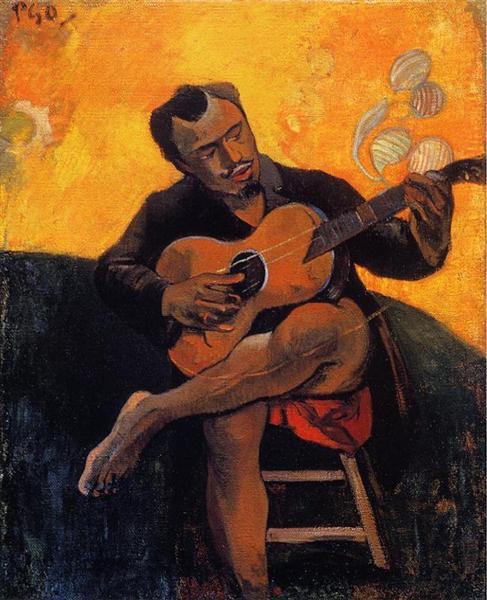Description
In The Guitarist from 1894, Paul Gauguin presents a work that encapsulates the artist's search for the primitive and the symbolic, a leitmotif that would characterize his production in this period. This painting, which falls within his post-impressionist phase, is based on a cumulative approach to color and form that reinterprets reality in a deeply personal way. The composition of the work shows us a young man sitting with a guitar in an environment that evokes tranquility and meditation. The character, with sallow skin and wide areas of color, suggests an indigenous origin, reflecting Gauguin's interest in the culture of the Polynesian peoples and their traditions.
The choice of the guitarist as the protagonist is significant; the guitar symbolises music, art and expression. The character, with an introspective gaze, seems immersed in the music emitted by his instrument, establishing a subtle link between the human figure and the musical, creating an atmosphere of serenity and contemplation. This focus on the isolated figure, in full concentration, is a recurring resource in Gauguin's work, which seeks not only to capture the image, but also the emotional state of the subject.
The colour palette used in The Guitarist is a clear example of the use of colour in a symbolic and expressive way. Vibrant shades of yellows and greens contrast with sections of more neutral colour, stylising and simplifying the shapes of the character and the surroundings. This bold use of colour highlights the influence of symbolism, where colour does not act solely as a visual descriptor, but enriches the emotional narrative of the painting. Known for his rejection of shadows and preference for flat tones, Gauguin uses colour to convey sensations rather than simple observations of reality.
The painting technique reveals Gauguin's distinctive style, characterized by thick lines and clear definition of forms, an approach derived from his interest in graphic arts and the direct application of paint. Compared to other contemporary artists, Gauguin achieves a simplification that evokes the vision of primitive artists, a point that he himself defended as a more authentic way of approaching art. "The Guitarist" can be seen as a manifestation of his desire to escape modernity and return to a purer and truer expression of the soul.
The work invites the viewer to reflect on the duality between the production of art and the inner life of the artist. In this sense, the young guitarist, immortalized in his world of emotions and melodies, transforms the painting into a visual meditation on the connection between music, culture and introspection. This painting, although less known than some of Gauguin's most emblematic works, is studied with interest for its unique approach to the deepest part of the human being through music and visuality.
At its core, The Guitarist does not merely represent a static moment, but suggests an inner movement, a flow of thoughts and passions that find their channel in musical expression. The work challenges our contemporary perceptions, reminding us that the true communication of art lies in its ability to transcend time and space, a value that remains relevant in the appreciation of Gauguin's work and his legacy in art history.
KUADROS ©, a famous painting on your wall.
Hand-made oil painting reproductions, with the quality of professional artists and the distinctive seal of KUADROS ©.
Painting reproduction service with satisfaction guarantee. If you are not completely satisfied with the replica of your painting, we will refund 100% of your money.

